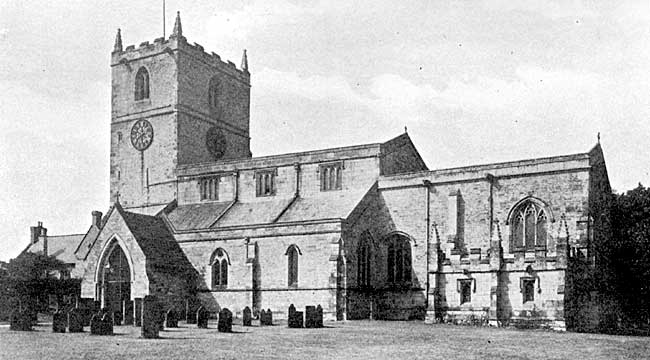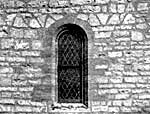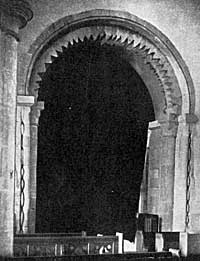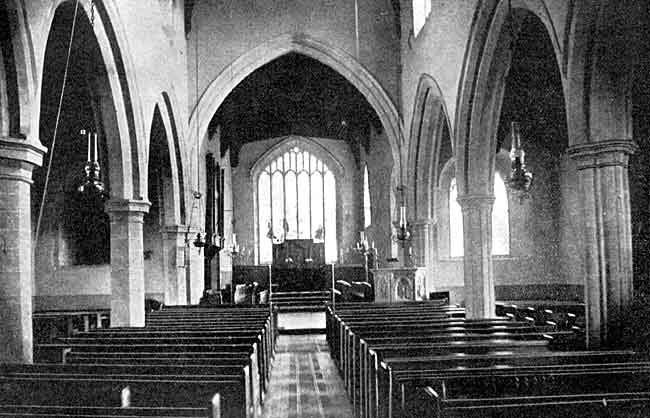WARSOP CHURCH
By The Rev. A. Du Boulay Hill.

Plate I. Warsop church.
The Domesday Survey, 1086, records that at Warsop there was a priest, a church, and a mill. The main part of Warsop, which had belonged before the Conquest to three Saxon lords, Godric Leuiet and Ulchel, was one of the 174 manors in Nottinghamshire held by the great Norman baron Roger de Busli.
In 1232-3 a grant was made by Henry III. of the manor with advowson of the church, on the gift of Olive, daughter of Alan son of Jordan, in her widowhood, to Robert de Lexington,1 an ecclesiastic, whose brother John bestowed it upon his wife’s nephew Robert de Sutton, lord of the manor in 1268. In 1329 the manor had come into the possession of John Nunnes of London, from whom it passed with the advowson to Sir John de Roos, and continued with the Earls of Rutland till 1675; then by purchase to the Knight family, and in 1846 by will to Sir Henry Fitz-Herbert of Tissington.2
The Church of SS. Peter and Paul, Warsop, is beautifully situated on rising ground, above the water of the Meden, widened here by a mill-dam, in pleasing contrast with the prosaic character of the populous mining villages of Market Warsop and Church Warsop, of which the church occupies the northern extremity.
It is a fine church, carefully restored in 1877; with western tower, a clerestoried and parapeted nave of three bays with north and south aisles and south porch, and a large chancel with modern organ chamber on the north, and a picturesque vestry of quite late 15th century on the south side, consisting of two bays with embattled parapet, emphasized by rather heavily pinnacled buttresses.
I think it is quite possible that some pre-Conquest work is preserved in the south and west faces of the tower, where the wide-jointed rude masonry has some peculiar characteristics.

Plate II. Warsop church. West face of tower.
The tower in plan is wider from north to south than from east to west. On the west face about 12ft. from the ground is to be noticed a curious course of dressed stones of triangular shape fitted together in mosaic fashion reminiscent of certain late Roman wall facing. [Plate II] In the second stage an original narrow belfry light remains on the south side, with an incised splayed-armed cross cut on the stone which forms the circular head of the window.
The tower must have collapsed at an early period, for the south-west angle has been entirely re-built, with a Norman buttress to the lower stage and a circular stair within the angle; while immense buttresses have been added later, on the north-west and on the east side. A rounded string-course below the third or upper (14th century) stage is curiously finished off at each of the angles by flat disc-like ends representing the mould as carried through the angle.

Plate III. Warsop church–Tower arch.
Passing now to the interior of the church, we find a tower arch to the nave of an unusual character. [Plate III] It is of two orders, the inner order consisting of a roll soffit on each side of which is worked a series of triangular teeth or zig-zags pointing radially inwards. Each point occupies a single voussoir, and as these are variable and small in size, especially towards the crown of the arch, and there is no ornament or moulding cut upon the architrave formed by the flat face of the teeth, the effect produced is that of somewhat barbaric richness. It was probably the intention to place a zig-zag moulding upon the edges of the teeth, but this has been left unfinished.
The arch is supported on half-round engaged shafts with a square chamfered abacus, and long conical capitals with slightly indicated volutes, and a small cable neck-mould. The outer order of the arch has a simple roll edge, the line of which is continued down the angle of the shafts on the eastern face by a string of elongated and rounded billets.
The zig-zag decoration is not found in the earliest Norman work, and I consider it probable that this arch was inserted in an earlier tower, in the first quarter of the 12th century.

Plate IV. Warsop church—interior.
The nave of three bays [Plate IV.] has on its south side an arcade of the end of the 13th century with pillars of four engaged filleted shafts and a bench-table or seat round the bases, while in the north arcade of some fifty years earlier the pillars have octagonal shafts and capitals, and high bases, the western respond having a keeled shaft and octagonal abacus. The re-built north aisle retains its original doorway with round chamfered arch now blocked up, and has squareheaded 14th century windows. The south aisle has been considerably altered, new windows and a parapet being added at the restoration. There is a fine 13th century porch with angle shafts and nail-head ornament in an angle of the rollmould.
A clerestory was added in the 15th century, when the chancel arch was also raised about 3ft., to suit the increased height of the nave, by placing short shafts with embattled capitals upon the capitals of the earlier responds.
A single corbel in the east wall of the north aisle is all that remains to indicate the position of either of the side altars.
The spacious chancel retains its 14th century plan, and one of its handsome windows of three lights on the south, the sill of which has been raised on account of a building added externally. There are also sedilia of a usual Nottinghamshire character, with four ogee arches under a horizontal hood-mould, the easternmost containing a piscina with quatrefoil bowl, and the other three having seats at different levels for celebrant, deacon and sub-deacon, probably more deeply recessed in their original condition.
The other windows of the chancel are later insertions. In the 15th century the large six-light east window was inserted, which has recently been filled with good glass (1906) by Srigley and Hunt of Lancaster. The fine roof is of the same date, and was erected when the clerestory was added to the nave, as may be seen externally where the same parapet is continued round nave and chancel roof. The roof has four slightly cambered tie-beams supported by well-carved angels bearing shields upon corbels in the walls. The centre boss upon one beam shows a lion passant sunk within an oblong border.
(1) Thoroton’s History of Notts.
(2) Warsop Parish Registers. Rev. R. J. King.
